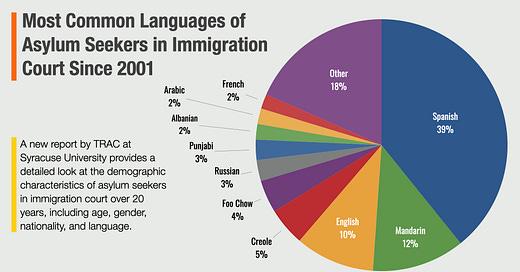TRAC Releases New Asylum Data on Nationality, Language, Age, and Gender
It’s report day at TRAC! One of my favorite things about working at TRAC is having the opportunity to share research with the public. Today we released a new report that looks at the demographics of asylum seekers in immigration court. Here is a copy of the press release that the university sent out for your benefit.
Language, gender, and nationality play a significant role in who gets asylum in immigration courts according to a new report on 20 years of asylum data from the Transactional Records Access Clearinghouse (TRAC) at Syracuse University.
Key findings from 20 years of data include:
The highest success rates among asylum applicants are from Nepal (73%), Ethiopia (72%), China (67%), Cameroon (66%), and Russia (66%).
The lowest success rates among asylum applicants are from Mexico (15%), Honduras and Haiti (each 18%), Guatemala (19%), and El Salvador (20%).
Chinese applicants were by far the largest group of asylum seekers.
Under Biden, asylum seekers from Venezuela, Cuba, and El Salvador have seen the biggest increases in asylum success rates in court.
39% of all asylum applicants are Spanish speakers over two decades. In FY 2001, Spanish-speakers comprised just 14 percent of all asylum cases but by FY 2020 represented 71 percent of asylum seekers.
Other languages include: Mandarin (12%) and English (10%) come in second and third for all cases, with Creole (spoken mainly in Haiti) and Foo Chow (spoken mainly in China) coming in fourth and fifth.
Unlike in the past, more cases now include gender data. For FYs 2020 and 2021, 55% of asylum seekers were male, and 45% were listed as female. But females show an 11.0 percentage point rise in asylum approval in FY 2021, compared with just a 5.7 percentage point increase for males—about half the increase.
Juveniles have generally lower asylum grant rates than adults in Immigration Court data covering FY 2020. For example, that year those up to 4 years of age were granted asylum only 19 percent of the time.
View TRAC’s detailed asylum report with many more important findings here: The Impact of Nationality, Language, Gender, and Age on Asylum Success. TRAC has also released three new and updated interactive asylum data tools here that allow the public to view the data for themselves.
As always, TRAC’s work is a collective effort from an amazing team, not solely or even predominantly my own work, but I share it for your benefit and to promote TRAC.




